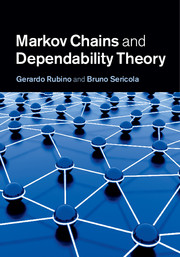Book contents
- Frontmatter
- Contents
- 1 Introduction
- 2 Discrete-time Markov chains
- 3 Continuous-time Markov chains
- 4 State aggregation
- 5 Sojourn times in subsets of states
- 6 Occupation times of subsets of states – interval availability
- 7 Linear combination of occupation times – performability
- 8 Stationarity detection
- 9 Simulation techniques
- 10 Bounding techniques
- References
- Index
4 - State aggregation
Published online by Cambridge University Press: 05 July 2014
- Frontmatter
- Contents
- 1 Introduction
- 2 Discrete-time Markov chains
- 3 Continuous-time Markov chains
- 4 State aggregation
- 5 Sojourn times in subsets of states
- 6 Occupation times of subsets of states – interval availability
- 7 Linear combination of occupation times – performability
- 8 Stationarity detection
- 9 Simulation techniques
- 10 Bounding techniques
- References
- Index
Summary
In this chapter we analyze the conditions under which the aggregated process constructed from a homogeneous Markov chain over a given partition of its state space is also a homogeneous Markov chain. The results of this chapter mainly come from [89] and [91] for irreducible discrete-time Markov chains, in [94] for irreducible continuous-time Markov chains, and [58] for absorbing Markov chains. A necessary condition to obtain a Markovian aggregated process has been obtained in [58]. These works are based on the pioneering works of [50] and [1]. They are themselves the basis of other extensions such as [56], which deals with infinite state spaces, or [57] in which the author derives new results for the lumpability of reducible Markov chains and obtains spectral properties associated with lumpability.
State aggregation in irreducible DTMC
Introduction and notation
In this first section we consider the aggregated process constructed from an irreducible and homogeneous discrete-time Markov chain (DTMC), X, over a given partition of the state space. We analyze the conditions under which this aggregated process is also Markov homogeneous and we give a characterization of this situation.
The Markov chain X = {Xn, n ∈ N} is supposed to be irreducible and homogeneous. The state space is supposed to be finite and denoted by S = {1, 2, …, N}. All the vectors used are row vectors except when specified. For instance, the column vector with all its entries equal to 1 is denoted by 1 and its dimension is defined by the context.
- Type
- Chapter
- Information
- Markov Chains and Dependability Theory , pp. 94 - 124Publisher: Cambridge University PressPrint publication year: 2014

